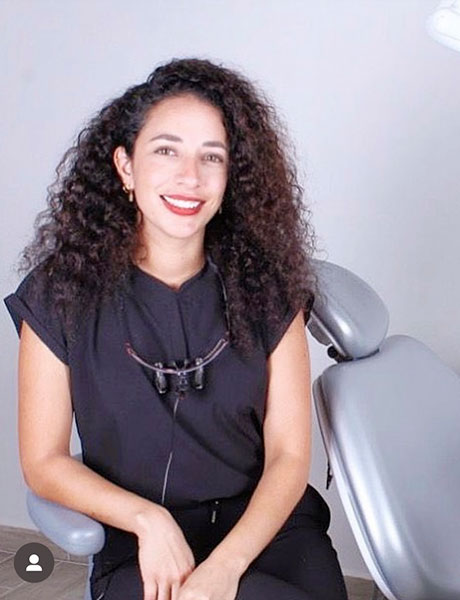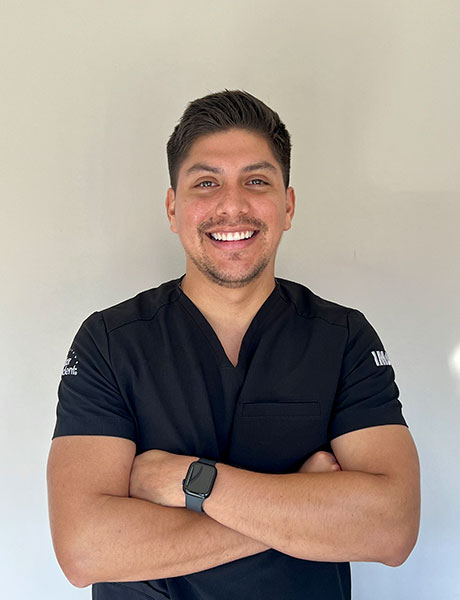
Dr. Eli Bustamante
Graduated from the Universidad Autonoma de Nuevo Leon in Dentistry, with more than 7 years of experience and specialist in periodontics and dental implants, the specialist Eli Bustamante is the author of indexed publications, presentations and national and international papers, continues with constant updates in high level congresses both nationally and internationally as she stresses the importance of being updated with the latest trends to provide you with the best quality of service.
See treatments
Dr. Steffany Carrales
Steffany is a specialist in orthodontics, with more than 7 years of experience. She studied dentistry at the Autonomous University of Nuevo Leon, specializing in orthodontics at BUAP. Certified in Invisalign.
See treatments
Dr. Humberto Benitez
Specialty in Oral Rehabilitation and Implantology.
With more than 8 years of experience, he has multiple and constant updates in
the area of dental cosmetics and digital workflow dentistry

Dr. Iliana Astorga
Specialty in Prosthodontics.
Specialty in Prosthodontics at the Autonomous University of Baja California in
the city of Mexicali. My focus is restoring dental conditions, providing oral
function and aesthetics through prosthetics, implants, crowns and veneers.
Dr. Eli Bustamante is responsible for restoring health to bone and gums, which are the structures
surrounding the tooth, is the main basis for any dental treatment such as veneers, crowns, orthodontics,
etc. for any treatment to work we must ensure the support structures.
If you have noticed that your gum is swollen, red, bleeding or bad food you need a consultation with
Periodontics.
Invisalign:
Invisalign is an orthodontic system that uses custom-made clear aligners to straighten teeth. It is a
discreet and comfortable alternative to traditional braces. The aligners are removable and are changed
every two weeks to gradually adjust to the desired position of the teeth.
Conventional Braces:
Conventional braces are metallic or ceramic brackets that adhere to the teeth to correct their position.
These brackets are connected by metal wires that apply pressure to gradually move the teeth to the
desired position. They are an effective option for correcting dental alignment, but they are more
visible than aligners.
Fixed Retainer:
The fixed retainer is a device used after orthodontic treatment to maintain the teeth in their new
position. It consists of a thin wire that is attached to the back of the teeth with dental cement. The
fixed retainer is invisible from the outside and helps prevent the teeth from returning to their
original position. It is an important measure for maintaining the results of orthodontic treatment in
the long term.
Esthetic Braces:
Esthetic braces are an alternative to traditional metallic braces and are designed to be less visible.
They are similar to metallic braces, but they are made of ceramic or porcelain that blends with the
color of the teeth, making them less noticeable.
Dental resins, also known as composite resins or dental restorative materials, are synthetic materials
used in dentistry to repair damaged, decayed or worn teeth. Dental resins are chemically bonded to the
tooth and can be molded and hardened by exposure to a special light, known as polymerization light. They
are widely used for aesthetic restorations, such as filling cavities, reconstructing fractured teeth or
improving the appearance of teeth through cosmetic dentistry procedures, such as dental veneers.
Tooth whitening is a cosmetic procedure used to lighten the color of teeth and remove surface stains and
discolorations. It is usually performed using whitening gels containing hydrogen peroxide or carbamide
peroxide, which work by penetrating the tooth enamel and oxidizing the pigment molecules that cause
stains. Teeth whitening can be performed in the dental office by a professional or at home, using teeth
whitening kits provided by the dentist. It is important to follow the dentist's instructions and have
realistic expectations about the results of teeth whitening.
In a professional dental cleaning, the term "prophylaxis" refers specifically to the procedure in which
plaque and tartar are removed from the teeth to prevent periodontal disease and maintain good oral
health. Therefore, a "dental prophylactic" can refer to both home oral hygiene practices and procedures
performed by a dental professional to prevent dental disease.
Dental extractions are procedures in which one or more teeth are removed from the mouth. This may be
necessary for a variety of reasons, such as:
1. Damaged or fractured teeth that cannot be repaired.
2. Teeth affected by deep cavities that cannot be successfully treated.
3. Teeth that cause alignment or crowding problems.
4. Baby teeth that do not fall out naturally to make way for permanent teeth.
Tooth extractions can be performed using different techniques, depending on the situation and complexity
of the case, and can be performed by a general dentist or an oral surgeon, as needed. After extraction,
it is important to follow the dentist's instructions for proper healing and postoperative care.
Dental veneers are thin shells, usually made of porcelain or composite resin, that are placed on the
front surface of teeth to improve their esthetic appearance. They are used to correct problems such as
discoloration, wear, malformations or gaps between teeth.
Dental crowns are protective coverings that are placed over a damaged or weakened tooth. They are
designed to restore the shape, function and appearance of the tooth, providing additional protection.
Dental crowns can be made of different materials, such as porcelain, metal or a combination of both, and
are used to cover teeth that have undergone treatments such as root canals, fractures or major
reconstructions.
Prostheses on dental implants are prosthetic devices used to replace one or more missing teeth using
dental implants as support. These prostheses can be of different types, such as single crowns, fixed
bridges or complete dentures (full dentures) that are attached to dental implants to restore the
function and esthetics of the missing dentition. Dental implants provide a solid, durable foundation to
support dentures, allowing patients to regain the ability to chew, speak and smile with confidence.
Dental microabrasion is a cosmetic procedure used to remove surface stains and discolorations from tooth
enamel. It involves applying a mild acid gel to the tooth surface and then gently scrubbing with an
abrasion tool, which can be a special type of toothbrush or a low-speed instrument. This technique helps
to remove surface stains caused by factors such as the consumption of coffee, tea, red wine or tobacco,
returning the tooth to its more natural and shiny appearance.
